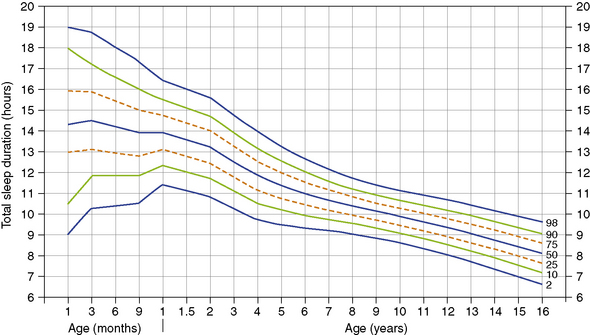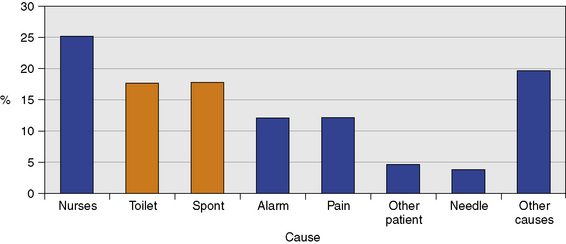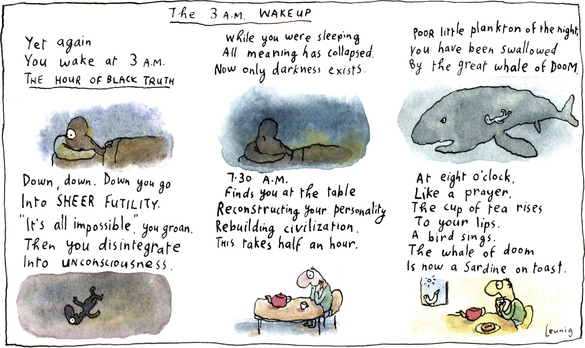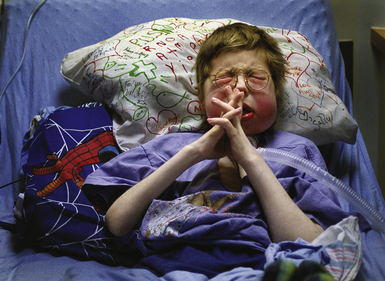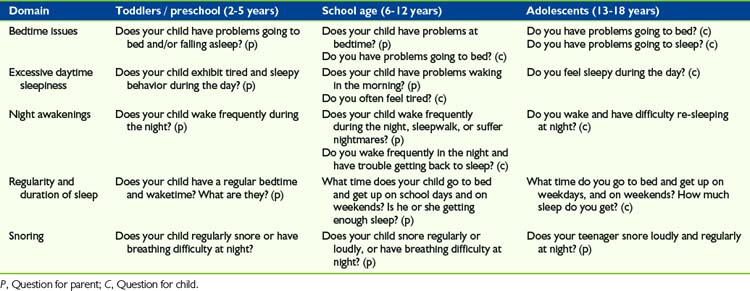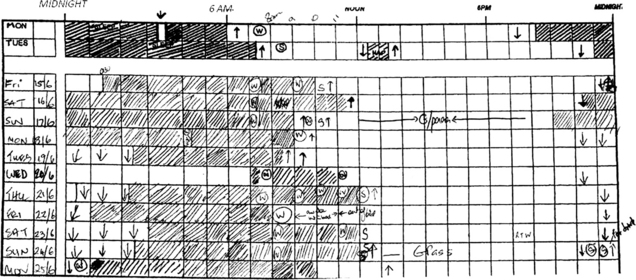30 Sleep and Insomnia
Since antiquity, sleep has been considered a time of healing, mending, and restoration.1 Sleeping difficulties are a significant issue for many healthy children and adolescents and are further increased in children suffering from life-threatening conditions. This can have a significant impact on both the child and his or her family. Lack of restful sleep can lead to impaired daytime functioning, increased pain, mood disturbances, altered immune function, and school or work problems for both children and parents.2–3 Sleep also provides an important respite for children with life-threatening conditions and their parents from the daily burden associated with managing their conditions.4
Classification of Sleeping Problems in Childhood
Sleep problems for children and adolescents can include:
Growth and Development
An understanding of normal developmental changes in children’s sleep patterns is helpful for both practitioners and families. Regular sleeping patterns generally become established by 12 months of age. Total sleep duration decreases from an average of 14.2 hours at 6 months of age to an average of 8.1 hours at 16 years of age10 (Fig. 30-1). There is a decreasing trend for daytime napping beyond the age of 12 months, with the most prominent decline in napping habits occurring between 18 months and 4 years of age.10 There is also a trend for children, particularly adolescents, to go to sleep at a later time compared with earlier eras, and this can be attributed to academic demands and entertainment, such as the Internet and television.10–12
Sleeping Difficulties in Healthy Children
Sleeping problems occur in healthy children. It has been found that 24% of children between 1 and 2 years still wake regularly at night.13 The frequency of disrupted sleep at night continues to decrease with age, with 10% of children waking at age 8.14 Sleeping problems are also important for adolescents, with 10% to 15% having difficulties falling asleep.14 Erratic sleeping patterns, partly associated with hormone secretion related to puberty, can make it difficult for some adolescents to fall asleep at bedtime. While nearly all teenagers show this tendency toward delayed sleep onset, approximately 7% will be diagnosed with delayed sleep phase syndrome in which the adolescent is typically unable to fall asleep before midnight and has extreme difficulty waking up in the morning.15 A national survey of 70,000 healthy children in the United States aged between 6 and 18 years showed 31.9% experienced more than one night of inadequate sleep in the week before the survey.16
Children with Life-Threatening Conditions
Sleep problems are magnified in children with respiratory, metabolic, neurologic, and malignant conditions. Insomnia can be considered a symptom in this group of children rather than a diagnosis. The cause may be peripheral in origin, such as gastroesophageal reflux causing pain or adenoidal hypertrophy with nasal obstruction causing respiratory difficulty. Alternatively, the causes of poor sleep may be central in origin, related to medications, brain tumors, seizures, and syndrome abnormalities with dysfunction of central sleep systems.17 In particular, pain and sleep-disordered breathing are prevalent problems in this patient population. Sleeping difficulties have also been noted to be present in children receiving end-of-life care.
Sleep complaints are common in children and adolescents diagnosed with cystic fibrosis (CF) with approximately 40% of children reporting difficulty falling asleep and a similar proportion having difficulty staying asleep.18 Hypoxemia and nocturnal cough account for some of these difficulties.19,20 Various metabolic and genetic syndromes are also associated with sleep disturbance, including Rett syndrome and Angelmann syndrome.21,22 Approximately 90% of children diagnosed with Sanfilippo syndrome have sleep disturbance.23
Structural brain lesions in infants and children are also often associated with difficulty falling asleep at night and nocturnal awakenings.24 States of wakefulness are regulated by brainstem nuclei, while the establishment of circadian rhythms is dependent upon the hypothalamus and its connections. Children with midline brain pathology and blindness are at high risk for sleep disorders resulting from desynchronization of the 24-hour sleep-wake rhythm. Children with hydranencephaly, in particular, can suffer from severe sleep disturbance, demonstrating the importance that intact cerebral hemispheres have in maintaining sleep-wake cycles.
Sleep-disordered breathing can occur in patients with chronic respiratory illnesses such as chest wall, neuromuscular, primary lung diseases and heart failure. Obstructive sleep apnea in children can be caused by enlarged tonsils or adenoids. Obesity, severe scoliosis, and craniofacial deformities may also contribute to sleep-related breathing problems.19 All of these risk factors for sleep-disordered breathing occur in children with life-threatening conditions.
Central and obstructive apneas are common and problematic for children with myopathies and other neuromuscular disease. Respiratory disorders during sleep, including apnea and hypoventilation, have been described in Duchenne muscular dystrophy and spinal muscular atrophy.19,24 Such children can experience ventilatory muscle fatigue, particularly in the latter hours of the night, resulting in disrupted sleep, daytime sleepiness, and headaches. Excessive daytime sleepiness was also a common sleep disturbance in children with brain tumors.25 Problems included resumption of daytime naps, difficulty waking in the morning, and inability to remain awake during daytime activities such as school.
Approximately 31% of children with cancer treated as outpatients experienced sleeping difficulties.26,27 This symptom was particularly distressing to 39% of 7- to 12-year-old children while 59% of 10- to 18-year-old children found this symptom to be particularly distressing. Children with cancer who are admitted to hospital for chemotherapy sleep for a longer duration and have more frequently disrupted sleep.28 One study revealed that 80% of children with cancer experienced significant pain at the time of their diagnosis. Almost 75% of children reported that this pain led to sleep disruption.29 The disruption of the sleep-wake pattern is a common issue adding to the fatigue that often accompanies cancer and its treatments.30
A survey of children attending a chronic pain clinic found that 71% had sleep disruptions.31 Pain has been found to contribute to children waking from sleep and affecting the overall quality of sleep in a number of studies.32,33 Pain may interfere with the ability to sleep because it can fragment sleep with frequent awakening, activate threat-related arousal to more pain, and increase vigilance that something worse may happen.34,35 Pain and discomfort affect sleep, while poor sleep predisposes a patient to increased, pain experiences.35,36 A study of healthy young adults found that reduced sleep led to increased sensitivity to pain.37 A bidirectional relationship between pain and sleep may ensue such that children enter a negative downward spiral in which worsening pain disrupts sleep, which then further heightens their pain experience.
Retrospective studies of children who died found insomnia to occur in 20% to 25% of children in the terminal stage of their disease.38,39 Fatigue is the most common symptom experienced at the end of life.39,40 Fatigue in children with cancer has been found to negatively correlate with sleep quality.28 Although anemia and metabolic changes may contribute to fatigue, sleeping poorly at night may be another important factor.34 Further, medications used to treat symptoms, such as opioid analgesics, antiepileptic drugs, and benzodiazapines, and keep children comfortable can also disrupt normal sleep patterns.41,42 Assessment can be difficult in the palliative care context where fatigue and sleepiness can arise from the disease state as well as sleep disturbance.
Effect of Hospitalization on Sleep
One survey of children ages 3 to 8 years who were admitted to a general pediatric unit found that they lost 20% to 25% of their usual sleep time.43,44 Children admitted to intensive care lost up to 50% of their sleeping time. These changes in sleep, such as reversal of the sleep-wake cycle, can persist for up to 7 weeks after discharge from the intensive care unit.45 A survey of children and adolescents admitted to The Children’s Hospital at Westmead, Sydney, Australia, found that the overall prevalence of poor sleep in children admitted to hospital was 52%.32 This survey included children with malignant and non-malignant life-threatening conditions, 19 and 11% of sample, respectively. The causes that woke children, in this survey, are presented in Fig. 30-2.
Sleep loss in the hospital is due to the underlying disease as well as environmental and psychosocial aspects associated with hospital admission.35 Many factors contribute to disturbed sleep, including noise, lights, lack of control, separation from parents, unfamiliar environment, loss of normal routine, anxiety, depression, and pain.28,44,46 Children may also have negative associations with their hospital bed if it is linked with stressors such as pain or procedures.
These studies highlight the benefits of home care in the palliative care context, given the numerous hospital related factors that disrupt sleep in children. Nevertheless, some children receiving palliative care will still require admission to the hospital at times for symptom management, respite, and end-of-life care.47 It is therefore important for hospital environments to be conducive to sleep for children, siblings, and parents in this context.
Psychosocial Factors
Although sleep is a physiologic process, it occurs in a psychosocial context. Psychological stressors that hinder sleep onset, such as anxiety, are common in pediatric palliative care. Other psychosocial factors known to impact sleep include parental education, family stress, and cultural factors.14,48 Children themselves may have worries about their clinical status, their situation, and fears of the dark compounded by legitimate fears of death. Fear, anxiety, depression, and anger at bedtime may make it difficult for the child to transition smoothly to sleep both at bedtime and at subsequent awakenings throughout the night. For the transition to sleep to be smooth, a child must feel safe.
Both research and clinical experience supports a relationship between childhood sleep problems and anxiety and other alterations in mood. Even modest amounts of sleep restriction result in difficulties regulating emotion and subsequent elevations in anxiety and depression.49 Sleep problems are commonly associated with anxiety with as much as 83% of anxious children experiencing significant sleep disturbance.50 Difficulty falling asleep, refusing to sleep alone, and nightmares are common, along with reduced total sleep time on school nights, frequent nighttime waking, and decreased deep sleep.50–52
The link between anxiety and sleep disturbance is both biological and behavioral. From a biological perspective, anxiety is characterized by dysregulation in the Hypothalamic Pituitary Adrenal (HPA) axis, resulting in increased secretion of cortisol which may negatively impact the timing and patterns of children’s sleep. Anxious children have been found to secrete higher levels of cortisol during the pre-sleep period than depressed and healthy controls.53 Children with anxiety may also elicit parenting responses that inadvertently maintain their sleep problems. Parents of anxious children frequently respond to their child’s anxiety by over-protecting and enabling avoidance, which inadvertently maintains anxiety by limiting opportunities for children to test their fearful predictions and develop coping skills.54,55 Parent-child interactions are similarly important in maintaining childhood sleep problems. Studies show that children who require or receive a high level of parental involvement at bedtime are more likely to have night-waking problems and vice versa.56 Thus, the interaction between anxiety, sleep problems and parent-child bedtime interactions may be particularly complex in the palliative care context.
Sleep problems are similarly associated with depression in young people. Sleep disturbances are reported in up to 90% of adolescents with major depression.57 Depression in young people tends to be associated with symptoms of insomnia, with polysomnogram (PSG) studies revealing reduced total sleep time, longer sleep onset latencies and shorter latency to REM sleep.58 Poor sleep quality and daytime sleepiness are also frequently reported.59 At times it can be unclear whether the sleep or the emotional disturbance is the primary problem. Traditionally, disturbed sleep has been viewed as a manifestation or symptom of psychological disorder. Increasingly, however, there is evidence of a bidirectional relationship between sleep and emotional and behavioral functioning. It also has a huge impact on the emotional status of the family who looks after the child. Parents and caretakers at night need rest and sleep to continue the taxing nature of caring for children on a daily basis.
Adolescents with a life-threatening illness will also have concerns related to growing up and planning for the future combined with a grief relating to multiple losses, including changes in friendships, physical appearance, and modification of future aspirations. Supportive communication with their parents may be lacking, and as a consequence they may stay in bed, awake, trying to deal with poorly understood anxieties.60 As the cartoon (Fig. 30-3) “3 am Wakeup” illustrates, it can be difficult for health professionals to fully appreciate the impact of a disturbed night’s sleep, particularly when we observe and assess patients in the light of day. Worries may occur at night when in a dark room and defenses are least able to cope. Sometimes as health professionals we may minimize sleeping difficulties and see it like a “sardine on toast,” while our patients see it as a “great whale of doom.” There is also a spiritual dimension to this distress (Fig. 30-4).
Assessment
It is important to undertake a thorough history and examination when assessing a child with sleeping difficulties. If children are fully awake for long periods at night and miserable despite being held, walked or fed, offered playtime, or brought into the parents’ bed, medical causes such as pain and cerebral irritability should be considered.17 Older children and adolescents are able to recall whether their sleep was restful and refreshing or restless and disturbed. In younger children, the parent acts as proxy. A simple and effective subjective method of rating sleep is that of a visual analogue scale —a 100-mm horizontal line with opposing statements such as “best sleep ever” and “worst night ever” at each end. The subject being assessed is asked to place a mark on the line in a position corresponding to their perception of the previous night’s sleep. The distance of that mark along the line may then be measured in millimeters, providing a numerical value for satisfaction with the previous night’s sleep. Each subject creates his or her own scale, which is extremely sensitive to change and therefore particularly useful for serial assessments.61
BEARS (Bedtime issues, Excessive daytime sleepiness, night Awakenings, Regularity and duration of sleep, Snoring) is a five-item pediatric sleep screening instrument that is useful in obtaining sleep-related information and identifying sleep problems and can be incorporated into taking a sleep history from a child or parent62 (Table 30-1). A sleep diary is another assessment tool that allows parents or older children to record periods of being asleep and being awake over a 24-hour period. There are also provisions to record the times, duration, and causes of awakenings throughout the night. Sleep diaries completed by parents are an accurate way of measuring sleep-schedule measures, that is sleep duration and sleep onset time, and can be completed over a number of days. It is often necessary for parents to complete sleep diaries on their child’s behalf, particularly where the child may still be developing an accurate sense of time. Children older than 12 years can accurately and reliably complete a sleep diary themselves63 (Fig. 30-5). Online sleep diaries are also available.51
An actigraph monitor is a small, lightweight, and watch-like device attached to the wrist and is capable of collecting time-based activity data over extended intervals. It is the gold standard to which sleep diaries are compared. Parents can overestimate the time their children spend in actual sleep and underestimate the number of their night-time awakenings.64 Actigraphy provides a non-invasive objective measure of sleep per week parameters in the child’s home environment. Nevertheless, sleep diaries remain an accessible and inexpensive way of assessing sleep in the clinical setting.
On occasion, it may be appropriate to use more advanced technology, such as a polysomnograph study. A polysomnograph is a laboratory-based test to diagnose and evaluate sleep disorders. It measures sleep, respiratory and other parameters (Table 30-2). It is not helpful in assessing insomnia because patients may sleep better than they normally do, or alternatively not sleep at all, due to the artificial environment of a sleep laboratory. It is particularly helpful for evaluating sleep-disordered breathing, or the assessment of upper airway obstruction and central sleep apnea. It also has a role in the pre-surgery assessment of patients at increased risk of anesthetic complications, such as spinal fusion for muscular dystrophy patients, and evaluation of patients after a brain tumor removal or spinal decompression. It can assist in the assessment of when to start non-invasive ventilatory support for at risk children, including those with neuromuscular conditions, and monitoring children receiving respiratory support during sleep such as supplemental oxygen, continuous positive airway pressure, and non-invasive ventilation.65 Collaboration and guidance from an experienced sleep pediatrician in relation to the appropriateness and use of these investigations is important.
TABLE 30-2 Components of Polysomnograph
| Category | Parameter and what it measures | |
|---|---|---|
| Sleep | ||
| Respiratory | < div class='tao-gold-member'> Only gold members can continue reading. Log In or Register to continue
Stay updated, free articles. Join our Telegram channel
Full access? Get Clinical Tree
 Get Clinical Tree app for offline access
Get Clinical Tree app for offline access

| |
